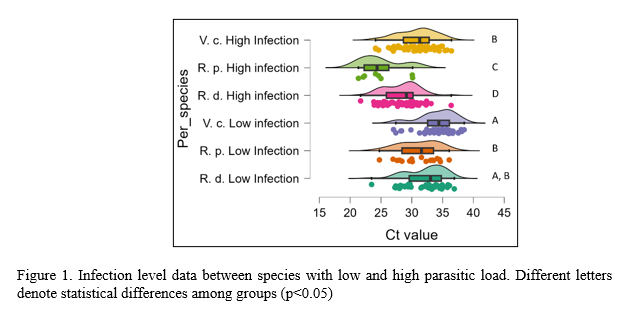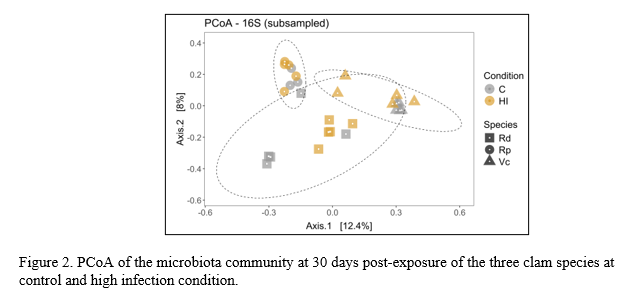EFFECTS OF Perkinsus olseni INFECTION IN MICROBIOME COMMUNITY, GENE EXPRESSION RESPONSE AND OVERALL PREVALENCE IN COMMERCIAL CLAM SPECIES
Introduction
The protozoan parasite Perkinsus olseni is a global threat to bivalve mollusks, with a deleterious effect in growth performance as well as reproduction capacity1 , including economically valuable species such as Ruditapes decussatus (RD), Ruditapes philippinarum (RP), and Venerupis corrugata (VC), the most economically valuable species of clams in Portugal.
This study was designed to mimic a natural infection and aimed to investigate the response of these three clam species to the parasite. Seed (5-7 mm length) was exposed with two different concentrations of parasite to identify the differential susceptibility of the species to the disease. The gene expression profile at short and long term was determined by RNA-Seq and also the microbiota community composition was evaluated.
Material and methods
After isolation of parasite hypnospores2, two different concentrations were added to tanks (Low Infection (LI) treatment 5x105 cells; High Infection treatment (HI) 5x106 cells). After 48 hours, water was renewed, and the progression of the infection was followed for one month. Samples were taken over four time periods (48 hours, 7-, 14- and 30-days post exposure) to assess short and longer-term responses. Presence and prevalence of parasite over time was evaluated by qPCR3 . Also, RNA was extracted from samples of 48 hours and 30 days’ post exposure. T he microbiota community was evaluated by the sequencing of the V3-V4 region of the 16S after isolating the DNA from the whole clam at 30 days’ post-exposure in control and HI treatment to verify if the infection had an impact on the community.
Results
While in HI treatment all clams became infected, in LI treatment the prevalence indicates a higher predisposition of RD and RP to the disease (97.5% and 76.6% prevalence, respectively), followed by VC (74.4% prevalence). Regarding the parasite load of infected individuals, results showed significant differences in the infection intensity of each clam species to the parasite, with RP showing higher parasite load throughout the experiment. Conversely, VC demonstrated a lower susceptibility to the parasite, with lower parasite load observed at short and long term while RD showed an intermediate response, falling between the other two species (Figure 1).
At transcriptomic level, all species seems to be compromised by the infection at both timepoints , functions such as immune system, reproduction and cellular proliferation were compromised, and just some functions such as dopamine norephrine biogenic amine related to stress responses and regulation of feeding networks were up-regulated4.
Regarding microbiota community, there is no clear impact on the composition after infection, but some groups seemed to be modulated by the parasite infection. On the other hand, there is a clear separation of the microbiota composition among species (Figure 2).
In conclusion, these findings highlight the variable response of three clam species to P. olseni , suggesting that VC may be less susceptible to the parasite, while RP may be the most susceptible. This study provides valuable information for understanding and managing the impact of P. olseni on clam populations.
Bibliography
1 Fernández-Boo S, et al. Effect of the alveolate parasite Perkinsus olseni infection on sexual maturation and spawning efficiency of the clam Ruditapes decussatus. 10.1017/S0031182023000082.
2 Casas, S. M., et al. Continuous in vitro culture of the carpet shell clam Tapes decussatus protozoan parasite Perkinsus atlanticus. doi.org/10.3354/dao052217.
3Garcia, A., et al. Evaluation of the Ruditapes decussatus immune response after differential injected doses of Perkinsus olseni. doi.org/10.1016/j.jip.2022.107849
4 Miller MW. Dopamine as a Multifunctional Neurotransmitter in Gastropod Molluscs: An Evolutionary Hypothesis. 10.1086/711293.
Acknowledgments
This work was funded by Pacto da Bioeconomia Azul (BPA), liderado pela Inovamar, S.A., with the reference # C644915664-00000026, funded by the Portuguese Republic and the European Union . CESGA (http://www.cesga.es) provided computing facilities.

